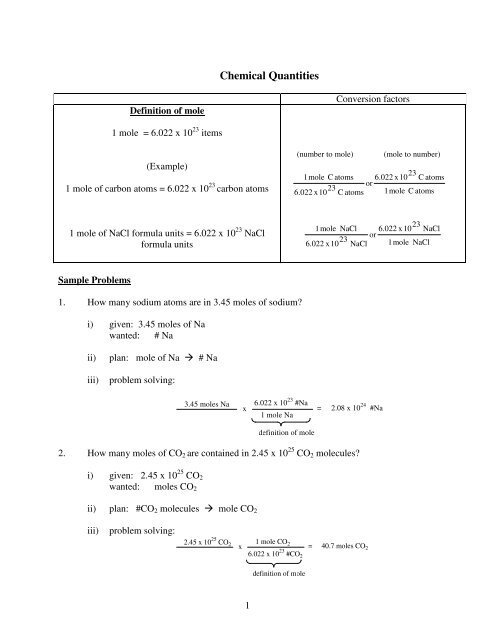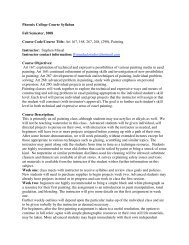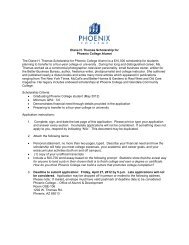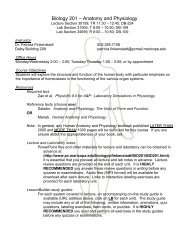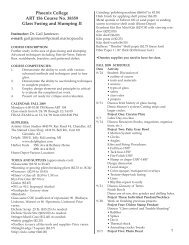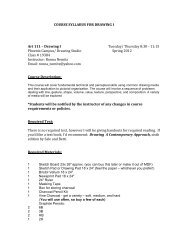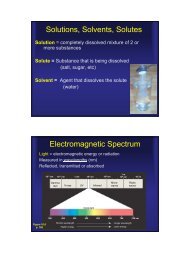Problem solving: Chemical Quantities/Stoichiometry (CHM130) (PDF)
Problem solving: Chemical Quantities/Stoichiometry (CHM130) (PDF)
Problem solving: Chemical Quantities/Stoichiometry (CHM130) (PDF)
You also want an ePaper? Increase the reach of your titles
YUMPU automatically turns print PDFs into web optimized ePapers that Google loves.
<strong>Chemical</strong> <strong>Quantities</strong><br />
Definition of mole<br />
Conversion factors<br />
1 mole = 6.022 x 10 23 items<br />
(Example)<br />
1 mole of carbon atoms = 6.022 x 10 23 carbon atoms<br />
(number to mole)<br />
1mole C atoms<br />
23<br />
6.022 x 10<br />
or<br />
C atoms<br />
(mole to number)<br />
23<br />
6.022 x 10<br />
C atoms<br />
1mole C atoms<br />
1 mole of NaCl formula units = 6.022 x 10 23 NaCl<br />
formula units<br />
1mole NaCl<br />
23<br />
6.022 x 10<br />
or<br />
NaCl<br />
23<br />
6.022 x 10<br />
1mole<br />
NaCl<br />
NaCl<br />
Sample <strong>Problem</strong>s<br />
1. How many sodium atoms are in 3.45 moles of sodium?<br />
i) given: 3.45 moles of Na<br />
wanted: # Na<br />
ii)<br />
iii)<br />
plan: mole of Na # Na<br />
problem <strong>solving</strong>:<br />
3.45 moles Na<br />
x<br />
6.022 x 10 23 #Na<br />
1 mole Na<br />
= 2.08 x 10 24 #Na<br />
definition of mole<br />
2. How many moles of CO 2 are contained in 2.45 x 10 25 CO 2 molecules?<br />
i) given: 2.45 x 10 25 CO 2<br />
wanted: moles CO 2<br />
ii) plan: #CO 2 molecules mole CO 2<br />
iii)<br />
problem <strong>solving</strong>:<br />
2.45 x 10 25 CO 2 x<br />
1 mole CO 2<br />
6.022 x 10 23 #CO 2<br />
= 40.7 moles CO 2<br />
definition of mole<br />
1
Molar mass of atoms<br />
(= mass of 1 mole of atoms)<br />
1 mole of atoms = mass (in grams) of atoms of an<br />
element<br />
(Example)<br />
In the periodic table<br />
element of carbon is shown as below.<br />
6<br />
C<br />
12.01<br />
This indicates one mole of carbon has a mass of 12.01<br />
g of carbon atoms.<br />
Therefore, 1 mole of C atoms = 12.01 g of C atoms<br />
(mass to mole) (mole to mass)<br />
1mole C 12.01g C<br />
or<br />
12.01g C 1mole C<br />
Sample problems<br />
A jewelry contains 0.0450 moles of silver metal. How many grams of silver metal does the<br />
jewelry contain?<br />
i) given: 0.0450 moles Ag<br />
wanted: g Ag<br />
ii) plan: mole Ag g Ag<br />
iii)<br />
problem <strong>solving</strong>:<br />
0.0450 moles Ag<br />
x<br />
107.87 g Ag<br />
1 mole Ag<br />
=<br />
4.85 g Ag<br />
molar mass of Ag<br />
2
Mole ratio and molar mass of compounds<br />
(Example 1)<br />
1 mole of CO 2 = 1 mole (C + 2O) = 1 mole C + 2 moles O<br />
Molar mass of CO 2 can be calculated as<br />
1 mole C = 12.01 g<br />
+ 2 moles of O = 2 x 16.00 g = 32.00 g<br />
44.01 g CO 2<br />
Therefore, 1 mole of CO 2 = 44.01 g CO 2<br />
(Molar ratio)<br />
1mole CO<br />
2 1mole C<br />
or<br />
1mole C 1mole CO<br />
2<br />
1mole CO<br />
2<br />
2 moles O<br />
1mole CO<br />
2<br />
44.01g CO<br />
2<br />
2 moles O<br />
or<br />
1mole CO<br />
2<br />
(Molar mass)<br />
44.01g CO<br />
or<br />
2<br />
1mole CO<br />
2<br />
(Example 2)<br />
1mole Ca(NO<br />
3<br />
)<br />
2<br />
1mole Ca<br />
(Molar ratio)<br />
1mole Ca<br />
or<br />
1mole Ca(NO<br />
3<br />
)<br />
2<br />
1 mole of Ca(NO 3 ) 2 = 1 mole (Ca + 2N + 6O)<br />
= 1 mole Ca + 2 moles N + 6 moles O<br />
1mole Ca(NO<br />
3<br />
)<br />
2<br />
2 moles N<br />
2 moles N<br />
or<br />
1mole Ca(NO<br />
3<br />
)<br />
2<br />
Molar mass of Ca(NO 3 ) 2 can be calculated as<br />
1 mole of Ca = 40.08 g<br />
2 moles of N = 2 x 14.01 g = 28.02 g<br />
+ 6 moles of O = 6 x 16.00 = 96.00 g<br />
164.10 g Ca(NO 3 ) 2<br />
1mole Ca(NO<br />
3<br />
)<br />
2<br />
6 moles O<br />
6 moles O<br />
or<br />
1mole Ca(NO<br />
3<br />
)<br />
2<br />
(Molar mass)<br />
1mole Ca(NO<br />
3<br />
)<br />
2<br />
164.10 g Ca(NO<br />
3<br />
)<br />
or<br />
2<br />
164.10 g Ca(NO<br />
3<br />
)<br />
2<br />
1mole Ca(NO<br />
3<br />
)<br />
2<br />
3
Sample <strong>Problem</strong>s<br />
1. How many moles oxygen atoms are contained in 0.125 moles of Al 2 (SO 4 ) 3 ?<br />
i) given: 0.125 moles Al 2 (SO 4 ) 3<br />
wanted: moles O<br />
ii) plan: mole Al 2 (SO 4 ) 3 mole O<br />
iii)<br />
<strong>Problem</strong> <strong>solving</strong>:<br />
0.125 mole Al 2 (SO 4 ) 3<br />
x<br />
12 moles O<br />
= 1.50 moles O<br />
1 mole Al 2 (SO 4 ) 3<br />
mole ratio<br />
2. What is the mass (in grams) of 0.018 mole of Mg(OH) 2 ?<br />
i) given: 0.018 mole Mg(OH) 2<br />
wanted: g Mg(OH) 2<br />
ii) plan: mole Mg(OH) 2 g Mg(OH) 2<br />
iii)<br />
problem <strong>solving</strong>:<br />
0.018 mole Mg(OH) 2<br />
x<br />
58.33 g Mg(OH) 2 = 1.05 g Mg(OH) 2<br />
1 mole Mg(OH) 2<br />
molar mass*<br />
*molar mass of Mg(OH) 2 :<br />
+<br />
1 mole of Mg = 24.31 g<br />
2 moles of O = 2 x 16.00 = 32.00 g<br />
2 moles of H = 2 x 1.01 g = 2.02 g<br />
58.33 g<br />
4
<strong>Chemical</strong> equations for reactions<br />
2H 2 + O 2 →<br />
2H 2 O<br />
(Mole ratio)<br />
2 moles H 2 : 1 mole O 2 : 2 moles H 2 O<br />
(Mole ratio)<br />
1mole H<br />
2<br />
1mole O<br />
or<br />
2<br />
1mole O<br />
2<br />
1mole H<br />
2<br />
1mole O<br />
2<br />
1mole H<br />
2<br />
O<br />
1mole H O<br />
or<br />
2<br />
1mole O<br />
2<br />
1mole H<br />
2<br />
1mole H<br />
2<br />
O<br />
1mole H O<br />
or<br />
2<br />
1mole H<br />
2<br />
Sample <strong>Problem</strong>s<br />
1. How many moles of carbon dioxide will be produced if 3.48 moles of propane gas (C 3 H 8 )<br />
reacted with oxygen gas (=combustion of propane gas)?<br />
C 3 H 8 +<br />
5O 2 3CO 2 + 4H 2 O<br />
i) given: 3.48 moles C 3 H 8<br />
wanted: moles CO 2<br />
ii) plan: mole C 3 H 8 mole CO 2<br />
iii)<br />
problem <strong>solving</strong>:<br />
3.48 moles C 3 H 8<br />
x<br />
3 moles CO 2<br />
= 10.4 moles CO 2<br />
1 mole C 3 H 8<br />
mole ratio<br />
(from coefficients in reaction equation)<br />
5
Exercises<br />
1. How many moles of NaCl are in 4.43 x 10 26 formula units of NaCl?<br />
2. Calculate the molar mass of calcium hydroxide, Ca(OH) 2 .<br />
3. What is the mass (in grams) of 4.55 moles of oxygen gas (O 2 )?<br />
4. How many moles of copper (Cu) are present in 0.0250 grams of copper?<br />
6
5. How many moles of oxygen atoms are in 0.300 g of Mg(OH) 2 (antiacid, laxative)?<br />
6. How many sulfur atoms are in 0.215 mole of Al 2 (SO 4 ) 3 (antiperspirant)?<br />
7. How many sulfur atoms are present in 5.50 g of carbon disulfide (CS 2 )?<br />
8. Iron metal reacts with oxygen gas to produce nitrogen iron(III) oxide.<br />
a) Write a balanced chemical equation.<br />
b) Write the mole-mole conversion factors (or mole ratio) between the pairs below.<br />
Iron and oxygen gas:<br />
7
Iron and iron(III) oxide:<br />
Oxygen and iron(III) oxide:<br />
9. Complete combustion of propane gas (C 3 H 8 ) produces carbon dioxide and water.<br />
a) Write a balanced chemical equation.<br />
b) How many moles of carbon dioxide will be produced if 12.0 g of propane gas reacted<br />
with excess amount of oxygen gas?<br />
10. How many moles of HCl gas can be obtained by reacting 11.5 g of hydrogen gas with 45.8<br />
g of chlorine gas? Which substance is the limiting reactant?<br />
H 2(g) + Cl 2(g) 2HCl (g)<br />
First, the amount of product (in moles) that can be produced from each reactant.<br />
Then, identify the limiting reactant. Reactant that gives the least amount of product is the<br />
limiting reactant.<br />
8
Answer key to Exercises<br />
1. How many moles of NaCl are in 4.43 x 10 26 formula units of NaCl?<br />
i) given: 4.43 x 10 26 # NaCl<br />
wanted: mole NaCl<br />
ii) plan: # NaCl mole NaCl<br />
iii)<br />
problem <strong>solving</strong>:<br />
4.43 x 10 26 # NaCl x<br />
1 mole NaCl<br />
= 736 moles NaCl<br />
6.022 x 10 23 # NaCl<br />
definition of mole<br />
2. Calculate the molar mass of calcium hydroxide, Ca(OH) 2 .<br />
1 mole Ca(OH) 2 contains 1 mole Ca, 2 moles O, and 2 moles H. Therefore,<br />
1 mole Ca = 1 x 40.08 g = 40.08 g<br />
+<br />
2 moles O = 2 x 16.00 g = 32.00 g<br />
2 moles H = 2 x 1.01 = 2.02 g<br />
74.10 g = molar mass of Ca(OH) 2<br />
3. What is the mass (in grams) of 4.55 moles of oxygen gas (O 2 )?<br />
i) given: mole O 2<br />
wanted: g O 2<br />
ii) plan: mole O 2 g O 2<br />
iii)<br />
problem <strong>solving</strong>:<br />
4.55 moles O 2<br />
x<br />
32.00 g O 2<br />
= 146 g O 2 (or 1.46 x 10 2 g O 2 )<br />
1 mole O 2<br />
molar mass of O2<br />
9
4. How many moles of copper (Cu) are present in 0.0250 grams of copper?<br />
i) given: grams Cu<br />
wanted: mole Cu<br />
ii)<br />
iii)<br />
plan: g Cu mole Cu<br />
problem <strong>solving</strong>:<br />
0.0250 g Cu<br />
x<br />
1 mole Cu<br />
63.55 g Cu<br />
= 3.93 x 10-4 mole Cu (or 0.000393 mole Cu)<br />
molar mass of Cu<br />
5. How many moles of oxygen atoms are in 0.300 g of Mg(OH) 2 (antiacid, laxative)?<br />
i) given: 0.300 g Mg(OH) 2<br />
wanted: moles O<br />
ii) plan: g Mg(OH) 2 moles Mg(OH) 2 moles O<br />
iii)<br />
problem <strong>solving</strong>:<br />
0.300 g Mg(OH) 2 1 mole Mg(OH) x 2 x<br />
58.33 g Mg(OH) 2<br />
molar mass of Mg(OH) 2<br />
2 mole O<br />
1 mole Mg(OH) 2<br />
= 0.0103 mole O<br />
mole ratio<br />
6. How many sulfur atoms are in 0.215 mole of Al 2 (SO 4 ) 3 (antiperspirant)?<br />
i) given: 0.215 mole Al 2 (SO 4 ) 3<br />
wanted: # of S atoms<br />
ii) plan: mole Al 2 (SO 4 ) 3 mole S # S<br />
iii)<br />
problem <strong>solving</strong>:<br />
0.215 mole Al 2 (SO 4 ) 3<br />
3 mole S<br />
x<br />
1 mole Al 2 (SO 4 ) 3<br />
x<br />
6.022 x 10 23 # S<br />
1 mole S<br />
= 3.88 x 10 23 # S atoms<br />
mole ratio<br />
definition of mole<br />
10
7. How many sulfur atoms are present in 5.50 g of carbon disulfide (CS 2 )?<br />
i) given: 5.50 g CS 2<br />
wanted: # S<br />
ii) plan: g CS 2 mole CS 2 mole S # S<br />
iii)<br />
problem <strong>solving</strong>:<br />
5.50 g CS 2<br />
x 1 mole CS 2 2 mole S<br />
x<br />
76.13 g CS 2 1 mole CS 2<br />
x<br />
6.022 x 1023 # S<br />
1 mole S<br />
= 8.70 x 10 22 # S atoms<br />
molar mass<br />
mole ratio<br />
definition of mole<br />
8. Iron metal reacts with oxygen gas to produce iron(III) oxide.<br />
a) Write a balanced chemical equation.<br />
4Fe (s) + 3O 2(g) 2Fe 2 O 3(s)<br />
b) Write the mole-mole conversion factors (or mole ratio) between the pairs below.<br />
Iron and oxygen gas:<br />
4 moles Fe<br />
3 mole O 2<br />
or<br />
3 mole O 2<br />
4 moles Fe<br />
Iron and iron(III) oxide:<br />
4 moles Fe<br />
2 moles Fe 2 O 3<br />
or<br />
2 moles Fe 2 O 3<br />
4 moles Fe<br />
Oxygen and iron(III) oxide:<br />
3 mole O 2<br />
2 moles Fe 2 O 3<br />
or<br />
2 moles Fe 2 O 3<br />
3 mole O 2<br />
11
9. Complete combustion of propane gas (C 3 H 8 ) produces carbon dioxide and water.<br />
a) Write a balanced chemical equation.<br />
C 3 H 8 + 5O 2 3CO 2 + 4H 2 O<br />
b) How many moles of carbon dioxide will be produced if 12.0 g of propane gas reacted<br />
with excess amount of oxygen gas?<br />
i) given: 12.0 g C 3 H 8<br />
wanted: mole CO 2<br />
ii) plan: g C 3 H 8 mole C 3 H 8 mole CO 2<br />
iii)<br />
problem <strong>solving</strong>:<br />
12.0 g C 3 H 8<br />
x 1 mole C 3H 8 3 mole CO<br />
x<br />
2<br />
44.11 g C 3 H 8 1 mole C 3 H 8<br />
= 0.816 mole CO 2<br />
molar mass<br />
mole ratio<br />
10. How many moles of HCl gas can be obtained by reacting 11.5 g of hydrogen gas with 45.8<br />
g of chlorine gas? Which substance is the limiting reactant?<br />
H 2(g) + Cl 2(g) 2HCl (g)<br />
First, the amount of product (in moles) that can be produced from each reactant.<br />
Then, identify the limiting reactant. Reactant that gives the least amount of product is the<br />
limiting reactant.<br />
i) given: 20.5 g H 2<br />
wanted: mole HCl<br />
plan: g H 2 mole H 2 mole H 2<br />
problem <strong>solving</strong>:<br />
11.5 g H 2 2 mole HCl<br />
x 1 mole H 2<br />
x<br />
2.02 g H 2 1 mole H 2<br />
= 11.4 moles HCl<br />
molar mass<br />
mole ratio<br />
12
ii) given: 45.8 g Cl 2<br />
wanted: mole HCl<br />
plan g Cl 2 mole Cl 2 mole HCl<br />
problem <strong>solving</strong>:<br />
45.8 g Cl 2 2 mole HCl<br />
x 1 mole Cl 2<br />
x<br />
70.90 g Cl 2 1 mole Cl 2<br />
= 1.29 moles HCl<br />
molar mass<br />
mole ratio<br />
iii)<br />
From the comparison of moles of HCl from i) and ii), reactant Cl 2 gives less amount<br />
of moles of HCl than other reactant H 2 .<br />
1.29 moles HCl < 11.4 moles HCl<br />
Therefore, Cl 2 is a limiting reactant.<br />
13


